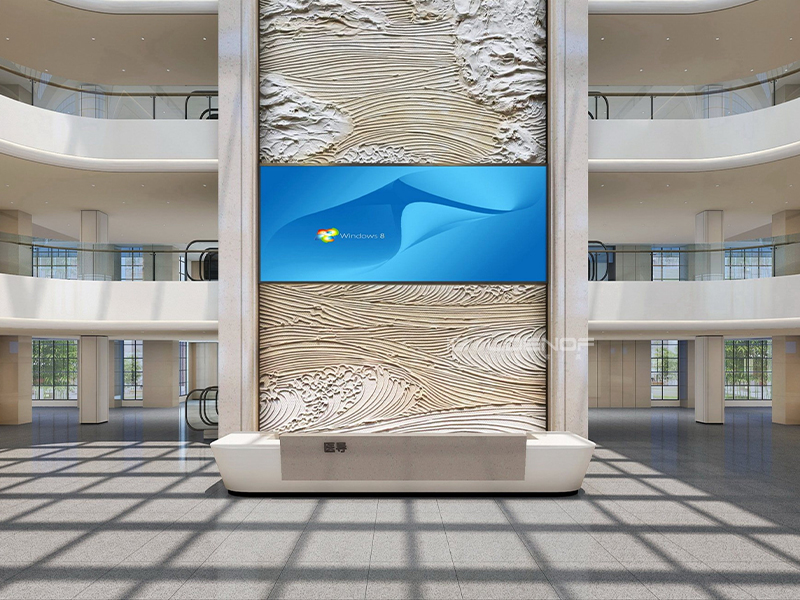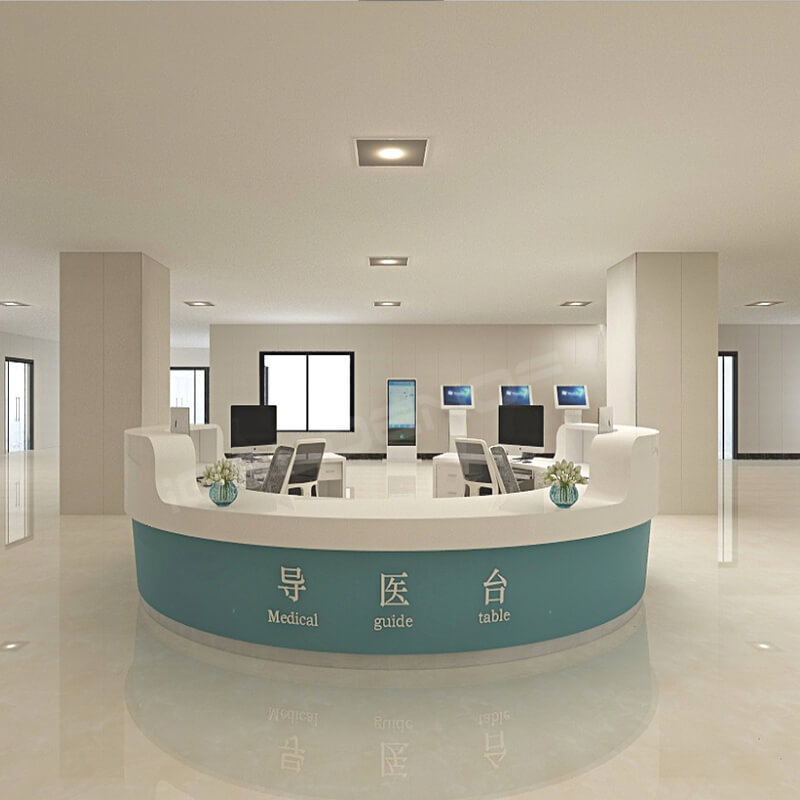In the planning of medical space, the role of the medical guide desk is by no means a “standard part that remains unchanged”. The layout, service process and patient groups of the outpatient halls of different hospitals are significantly different, which requires the medical guide desk to have strong adaptability. Our customized medical guide desk service is centered on “flexibility and adaptability”. From space utilization to functional configuration, from style presentation to detail processing, it fully meets the personalized needs of the hospital, so that each medical guide desk can be accurately integrated into a specific scene and become a “weapon” to improve service efficiency.
1. Space adaptation: Make the medical guide desk “seamlessly fit” with the venue
The spatial forms of hospital outpatient halls vary greatly. Some are as narrow and long as corridors, some are as square as halls, and some have irregular structures such as columns and corners. Standardized medical guide desks often find it difficult to cope with these complex scenes, while customized services can “tailor” the medical guide desk to perfectly integrate with the space.
For long and narrow halls, a “linear extension” medical guide table can be customized. The length can be flexibly adjusted from 2 meters to 8 meters according to the space, and the width is controlled between 0.8-1 meters. It will not take up too much horizontal space and can form a coherent service line. The tabletop can be designed in different areas, with a consultation window on the left, a data placement area in the middle, and a self-service query screen on the right, so that patients can receive services in an orderly manner in a long and narrow space.

When encountering a hall with columns, customized services can transform the columns into design highlights. For example, a “curved surround” medical guide table is built around the columns. The columns are cleverly wrapped inside the table body, which not only solves the problem of the columns being abrupt, but also uses the arc structure to guide patients to queue naturally. The gap between the table body and the columns is controlled within 5 mm to avoid sanitary dead corners, and at the same time, a maintenance channel is reserved for later maintenance.
For the compact space of small clinics or community hospitals, a “folding” or “combined” medical guide table can be customized. During off-peak hours, the side extensions can be folded and stored to save space; after unfolding during peak hours, the service area can be expanded by 50% to quickly cope with the pressure of traffic. This design is particularly suitable for medical institutions with large fluctuations in the number of daily visits.
2. Functional combination: “Building blocks” on demand, rejecting functional waste
The content of medical guide services in different hospitals varies greatly: general hospitals need to handle multiple tasks such as registration guidance, department consultation, and medical record issuance; children’s hospitals need to take into account comforting the emotions of sick children and answering parents’ questions; infectious disease hospitals need to focus on epidemic prevention, isolation, and disinfection convenience. Customized services use modular design to make functional configuration as flexible as “building blocks” to avoid unnecessary functional redundancy.
The basic modules cover three categories: data storage, equipment placement, and convenience services, and each category is further divided into multiple sub-modules. For example, the data storage module can choose a “drawer + cabinet door” combination, with drawer depths ranging from 15cm to 40cm. Shallow drawers are used to store test orders, and deep drawers are used to store brochures; cabinet doors can be locked or open, with locked models used to store emergency medicines and open models used to display hospital profiles.
For special functional requirements, customized services can provide “exclusive modules”. For example, the guide desk of a children’s hospital can be equipped with an “interactive toy area”, with a transparent acrylic box embedded on the side of the desk, and built-in safety toys, so that children can play with them while waiting to relieve tension; the guide desk of an infectious disease hospital can be customized with a “negative pressure isolation window”. The window uses double-layer tempered glass, with a transfer slot reserved in the middle. The guide staff and patients communicate through the glass to reduce the risk of direct contact. The transfer slot has a built-in ultraviolet disinfection device, and the items are automatically disinfected when they pass through.
The combination of functional modules can also be adjusted dynamically with the development of the hospital. For example, a hospital only needed basic consultation functions in the early stage, and customized a “simple” guide desk; two years later, a self-service registration service was added. Through the customized and adapted “extension module”, a self-service machine placement table was installed on the side of the original desk, without the need to replace the entire guide desk, saving upgrade costs.
3. Style Fusion: From “Incompatible” to “Integrated”
If the style of the medical desk is out of touch with the overall decoration of the hospital, it will appear abrupt and dazzling; while a highly integrated design can strengthen the brand tone of the hospital. Customized services make the medical desk an “organic part” of the hospital style through precise control of materials, colors, and shapes.
In Chinese-style hospitals, the medical desk can be made of walnut wood, with traditional patterns such as Huiwen and Xiangyun carved on the body, natural marble on the table top, and antique treatment on the edges. The columns are made of cylindrical solid wood, and Chinese carved capitals are added on the top, which echoes the carved beams and painted buildings and mahogany furniture of the hospital, creating a simple and elegant atmosphere.

Modern minimalist style hospitals are suitable for “minimalist” customized medical desks: the main body is made of silver-white aluminum alloy frame, the table top is made of pure white artificial stone, and the side of the table body is embedded with frosted glass, and the overall lines are straight and neat. It can be matched with hidden light strips, and the light shines through the gap between the glass and the countertop, creating a light and transparent visual effect, which complements the white walls, metal handrails and glass partitions of the hospital.
The theme hospital can also enhance its characteristics through customized medical guide desks. For example, the medical guide desk of an ophthalmology hospital can be designed into an “eyeball” shape, and the body of the desk is made of blue gradient acrylic material to simulate the texture of the eyeball iris; the dental hospital can incorporate “teeth” elements, and the edge of the countertop is made into an arc-shaped convexity, which resembles the arrangement of teeth, which not only echoes the characteristics of the department, but also is full of fun.
4.detail response: pay attention to “niche needs” and reflect the warmth of service
There are many “niche needs” that are easily overlooked in medical scenarios, and the flexibility of customized services is reflected in the precise response to these details, making the medical guide desk not only practical, but also more humanistic.
For hospitals with more elderly patients, the medical guide desk can be customized with a “low countertop + magnifying glass” combination. The height of the main table is reduced to 70cm, which is convenient for the elderly to bend over for consultation; a strip magnifying glass is embedded on the edge of the table, so the elderly do not need to hold it when checking the information, and can enlarge the font with a light touch, solving the problem of blurred vision. Handrails are installed on the side of the table, so that the elderly can use it at any time when they are unstable.
For the night emergency medical guide desk, the detailed design focuses on “nighttime convenience”: the table top is made of self-luminous material, which can emit soft light in the dark, making it convenient for medical guides to find items quickly; an induction light strip is installed at the bottom of the table, which automatically lights up when someone approaches, illuminating the area under the feet to avoid bumps at night; a fluorescent label is attached to the inside of the drawer, marking the name of the internal items, which can be identified without turning on the light.
In multilingual service hospitals, the medical guide desk can be customized with a “multilingual identification module”. A replaceable identification card slot is embedded in the edge of the table. According to the language ability of the staff on duty that day, Chinese, English, Japanese and other languages are inserted. International patients can quickly find the corresponding service window and reduce communication barriers.
The flexibility of the customized service of the medical guide desk is essentially a respect for the “diversity of medical scenarios.” It abandons the “one-size-fits-all” standardized thinking and focuses on the actual needs of the hospital. Through the full-dimensional flexible design of space adaptation, functional combination, style integration, and detail adaptation, the medical guide desk can truly become a “helper” rather than a “restraint” of the service.
Whether your hospital has a special space, complex functions, or a unique style and niche needs, we can create a “just right” medical guide desk through customized services. If you want the medical guide desk to better integrate into the hospital scene, you may wish to contact us and let the professional team unlock more flexible design possibilities for you.
